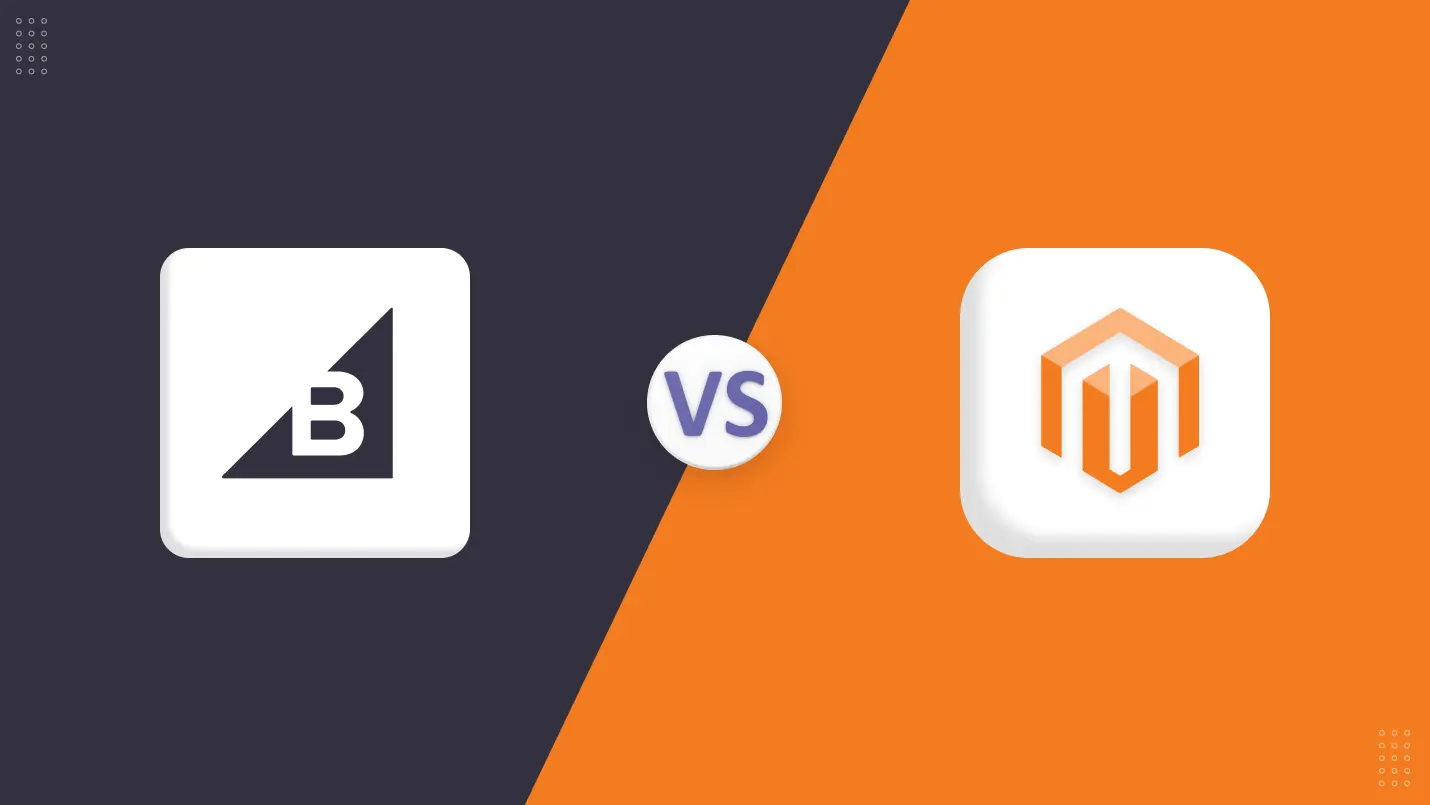The eCommerce marketplace is growing rapidly, expected to reach $6.3 trillion in global sales in 2024. Helping power that shift to online sales are eCommerce platforms like BigCommerce and Magento (now Adobe Commerce), two enterprise-level full-featured e-commerce content management system (CMS) platforms specifically designed with capabilities for larger and global organizations.
The main difference between BigCommerce and Magento (Adobe Commerce) is in format, with BigCommerce available as software-as-a-service (Saas) while Magento can be self-hosted (Magento Open Source or Adobe Commerce On-Premise) or as a hosted solution with platform-as-a-service (PaaS) as Adobe Commerce. To simplify, we will generically refer to all platforms as “Magento,” unless otherwise noted.
In this guide, you will find a full comparison between these enterprise eCommerce platforms, including a comparison of features, price, scalability, ease of use, customization, security and more.
Disclaimer: The information below is accurate as of March 22, 2024.
What Are the Key Differences Between BigCommerce and Magento?
As eCommerce has grown, we have seen the growth in eCommerce platforms (e.g. WooCommerce or Shopify) and more mature content management platforms (CMS) that also handle all the backend store management functions, such as BigCommerce and Magento, to offer seamless, multichannel experiences to customers. Choosing the right CMS platform is critical to setting your specific needs for your storefront – for beginners as well as for online store owners looking to scale with ease.
Whether you’re a business owner making the decision on the right platform, or you’re a web designer, developer or content manager trying to chime in on the decision, let’s examine the core differences between BigCommerce and Magento across critical factors, including:
- Price
- Functionality
- Scalability
- Ease of Use
- Customizability
- Security
Overview of BigCommerce
BigCommerce is an eCommerce platform that provides SaaS services to organizations to create online stores. Founded in Australia in 2009, BigCommerce supports 60,000 merchants.
When to choose BigCommerce:
- When you want a platform that is easy to use by both non-technical and technical audiences
- When you want the simplicity of a SaaS platform to offload tasks on site maintenance, security and scaling
- If you’re a smaller business or are just getting started, the ease of use and base features would be a great fit
Overview of Magento
Magento was first released in 2008 as an open-source eCommerce platform written in PHP. Magento was purchased by Adobe in 2018, with the continued availability of the open-source platform, including the update to Magento 2, as well as commercial versions specifically designed with new features to support larger businesses: Adobe Commerce On-Premises (self-hosted) and its two hosted offerings, Adobe Commerce Pro and Adobe Managed Services, the latter of which includes added customer support.
Magento is widely supported with online forms and global events and conferences. There are 145,371 stores running on the Magento platform, a combination of open-source and commercial figures.
When to choose Magento:
- If you are an established brand with internal technical resources or a trusted partner and are thinking long-term about scalability
- When you want more control and flexibility over the design or functionality of the store with rich plugins through partners
- When you are looking for rich features to support SEO or omnichannel retailing
- You are a multi-brand or global retailer and want to simplify in one platform
BigCommerce vs Magento: Pros and Cons
eCommerce platforms make it possible to sell to any customer, anywhere in the world, both businesses and consumers. We’ve put together a series of comparisons to help you decide between BigCommerce and Magento.
First, let’s look at the high level pros and cons between BigCommerce and Magento:
BigCommerce pros and cons
When compared to some of the smaller tools such as Wix or Spotify, BigCommerce offers a great deal of flexibility. However, when examining the enterprise space, BigCommerce lacks some of the agility compared to some of its more heavily-funded counterparts such as Magento.
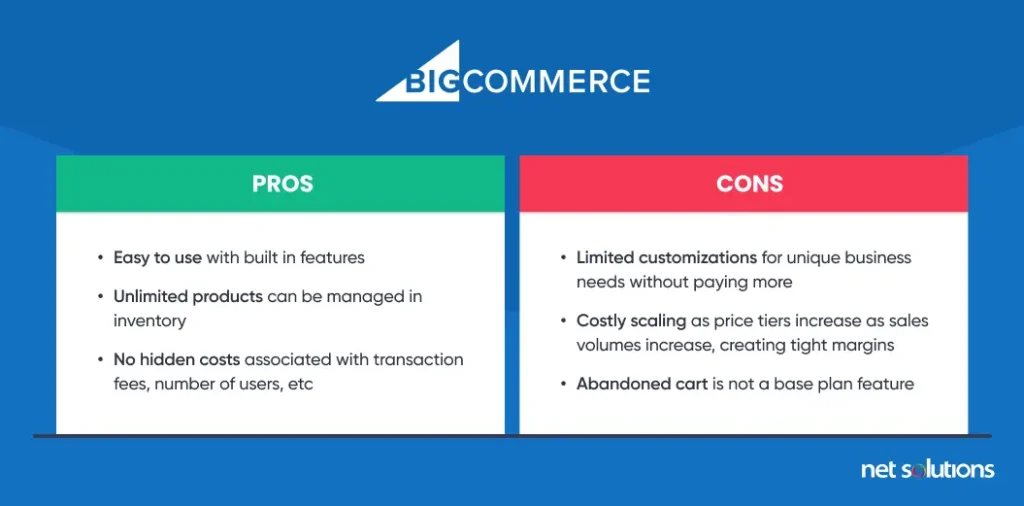
Magento pros and cons
Magento is backed by Adobe, allowing the cloud platform to leverage a significant number of features that are being built across services, including new features in AI. While Magento was previously considered quite complex, Adobe has been heavily investing in tools to eliminate this “con” from buyer considerations.
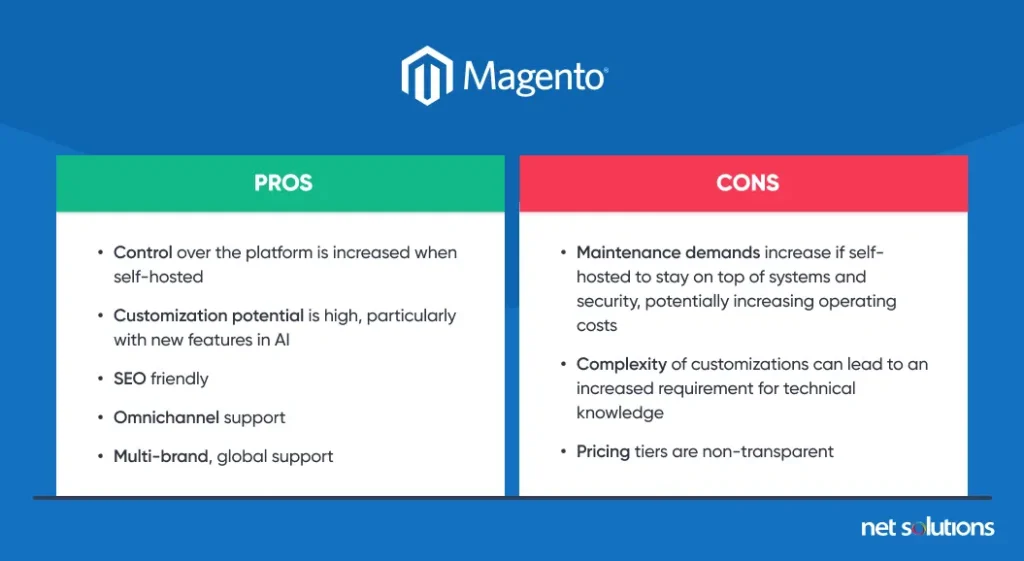
The choice in a CMS platform is ultimately determined by need and capacity: what your unique business needs are, what features you require, the capacity and technical skills you have for development, and what your growth plans are. Let’s examine Magento and BigCommerce in detail:
Magento vs BigCommerce: Features
The following table lays out a high-level view of Magento vs BigCommerce, with specific mention to the difference in Magento Open Source vs Adobe Commerce versions (where needed). Following the table, we will break down these features one-by-one.
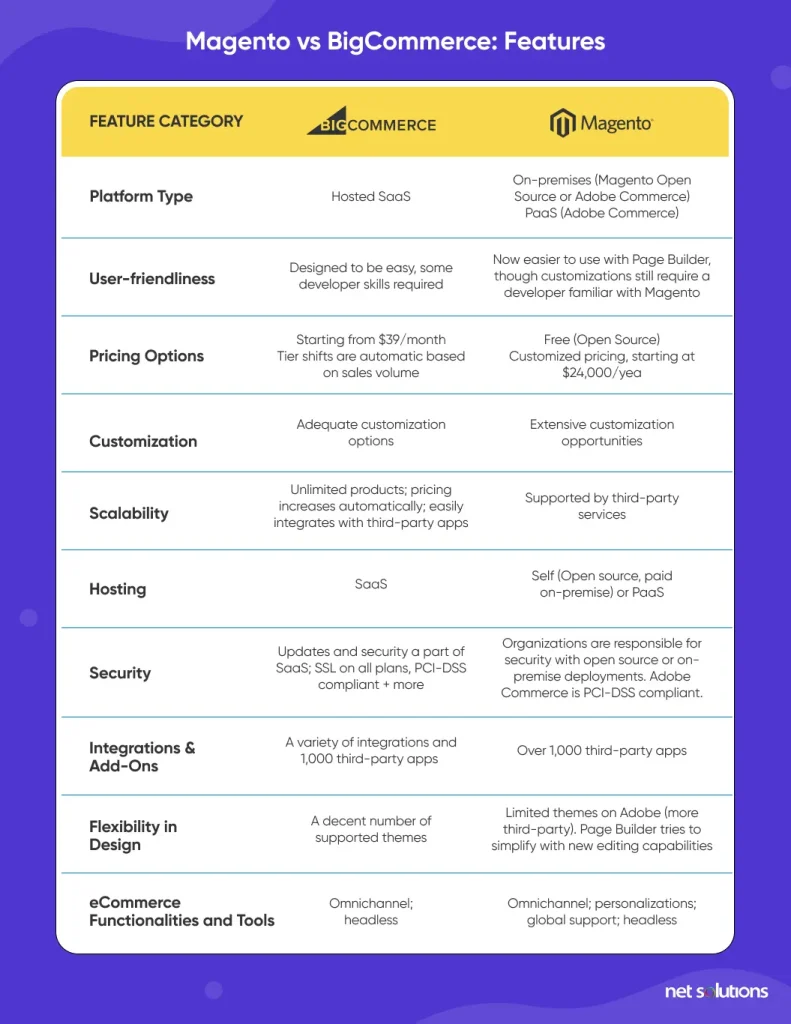
User-friendliness
An eCommerce platform is judged to be user-friendly if the dashboard is easy to use by people of all skill levels or if it features advanced capabilities such as drag-and-drop to help make an eCommerce website or eCommerce store. While historically BigCommerce was a leader here, Adobe has made inroads here, bringing us closer to a tie.
Ease of use for BigCommerce
BigCommerce is easy to set up and use, although some technical skill may be required. There are lots of templates to use and the dashboard is intuitive with a drag-and-drop Page Builder Visual Editor.
Ease of use for Magento
Magento is considered more difficult to use than BigCommerce, particularly the open-source version, but Adobe is investing in tools such as its AI (Sensei) and its drag-and-drop Page Builder to help brands launch websites without Magento development support.
Pricing options
BigCommerce pricing
BigCommerce is SaaS, so pricing reflects a lease on the software, managed and secured by BigCommerce, but not on any additional hosting costs. BigCommerce moves organizations to the next pricing tier automatically, opening up incremental benefits in credit card rate, search and cart capabilities. BigCommerce pricing plans are by a monthly fee or annual fee.
- BigCommerce Standard – $29 / mo
Unlimited number of goods, unlimited staff accounts, includes blog. - BigCommerce Plus – $79 / mo
The plus plan is designed for small business sales up to $180k annually, new features for abandoned cart, segmentation and stored credit cards. - BigCommerce Pro – $299 / mo
Designed for sales up to $400k annually, new features for search and SSL. - BigCommerce Enterprise – variable, $1000+ / mo
Offers more flexibility through unlimited API calls, unrestricted GMV limits, priority routing and support, and more customizations.
Magento pricing
Magento pricing depends on whether organizations are downloading the open source freemium version or the Adobe-owned commercial versions of the application. Commercial versions of the application can either be deployed on-premise (Adobe Commerce On-Premise) or as a complete cloud environment (Adobe Commerce Pro or Adobe Managed Services). Pricing is based on gross merchandise value (GMV) and average order value (AOV).
- Magento Open Source Edition – free
Magento Open Source is available to download and host (on-premises) for free, but all costs for hosting, security, SEO and maintenance are separate costs for the organization. - Adobe Commerce On-Premise – $24-$100k+ / year
License is for the base Commerce package, which includes greater functionality than the open source version (better search, Page Builder, B2B tools, preview, visual merchandising, advanced marketing). Does not include upgrades or add-ons. Supports 5 standard integrations. - Adobe Commerce Pro – $24-$100k+ / year
This enterprise plan has features to match the on-prem version, but with additional features such as included hosting, dedicated staging and deployment tools, data tools, image optimization, performance monitoring, and security features. - Adobe Managed Services – $24-$100k+ / year
Guarantees higher uptime, guaranteed service level response times, dedicated customer service and support, and onboarding assistance.
Note, previous versions of Adobe Commerce were listed as Adobe Commerce Cloud.
Flexibility in design
Although templates are an easy way to jump start the development of an online storefront, some brands want to be able to customize at the code level. For this, Magento is the clear winner (although that flexibility may come at an added cost).
Theme options in BigCommerce:
BigCommerce relies on PHP, PostgreSQL and standard languages for its themes, with 241 themes available (with some theme family repetition), of which 12 are free. Experiences can be customized with high-extensibility APIs.
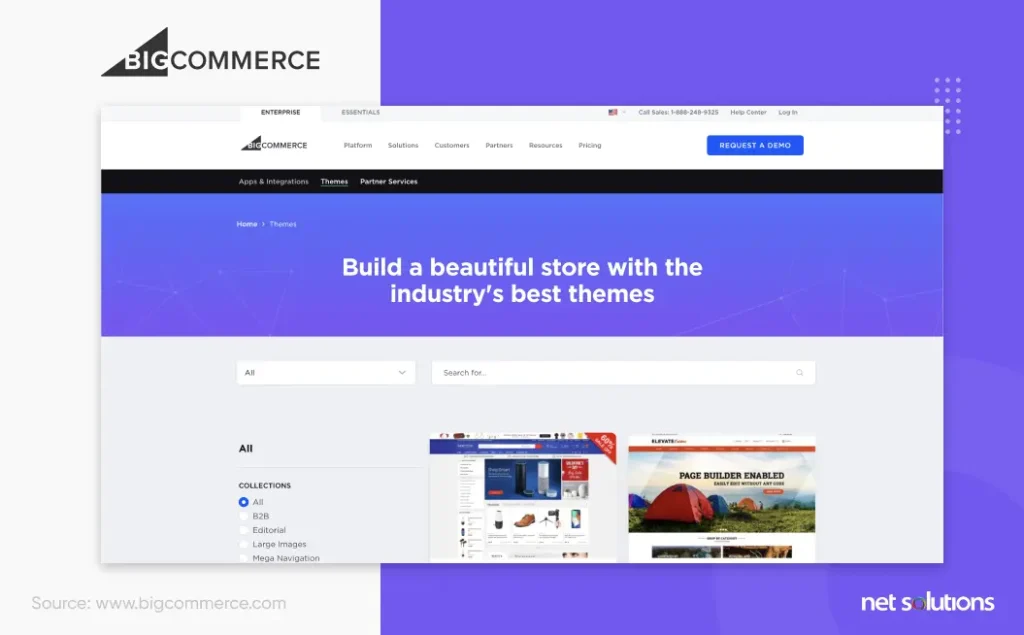
Theme options in Magento:
Adobe Commerce has a very limited number of themes on its own website, but there are hundreds of themes available in the global community. Magento has now made its designs much more intuitive to edit with adjustable page layouts for Magento stores, in-content editing, and personalization features built into its Page Builder.
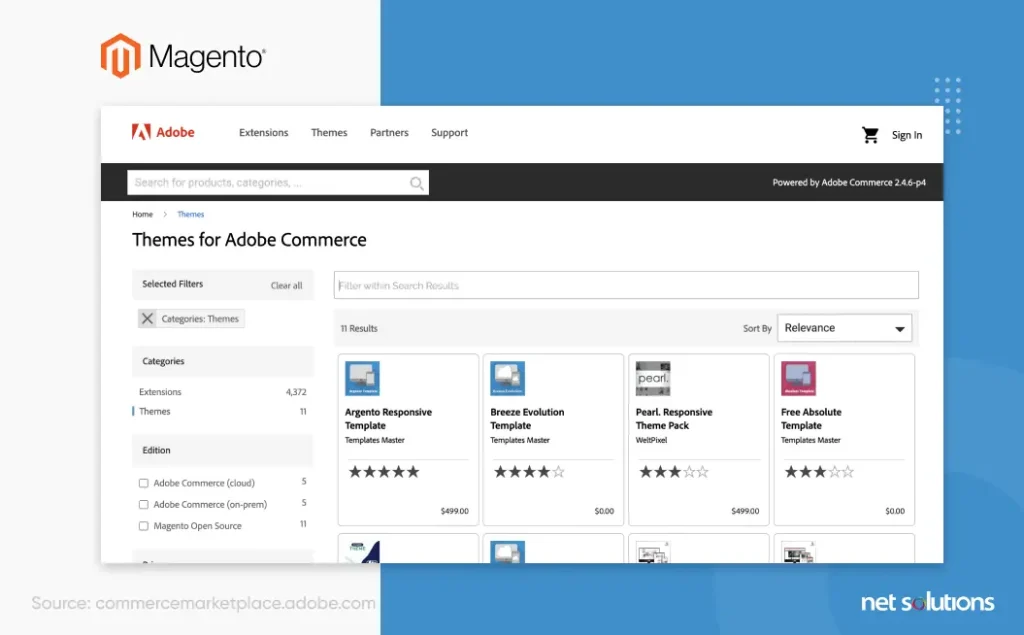
E-commerce functionalities and tools
In terms of features, BigCommerce has more native features, while Magento relies more on third-party paid add-ons. However, some of these features are quite sophisticated, so we’re going to name Magento the winner.
BigCommerce sales features
- Inventory management – unlimited products, native inventory management, sync inventory across locations (with POS add-on)
- Sales channels – headless, omnichannel commerce support for in-person and digital platforms with out-of the-box integrations with Amazon, eBay and Walmart
- Point of sale – can integrate with POS provider and third-party hardware of choice
Magento sales features
- Inventory management – Support for omnichannel commerce experiences
- Product catalog management through Catalog Service, a multi-tenant SaaS service (add-on) that displays product information to shoppers at fast speeds
- Sales channels – headless, omnichannel commerce support with support for Amazon (no add-on price)
- Personalizations – supports real-time personalizations based on customer segments such as AI-powered product recommendations
- Fulfillment – flexible fulfillment and sourcing to determine the closest location. Support for global brands.
Security and performance considerations
The winner here is BigCommerce, with a greater number of certifications and the overall benefit of providing security-as-a-service.
eCommerce Security is a critical function of any platform to help ensure that sensitive customer data remains secure. Security includes both the protections on the platform itself, such as access controls and firewalls, to the protections offered to customers in the form of support for strong multi-factor authentication.
BigCommerce supports role-based access controls, audit logs, and is compliant with PCI-DSS, SOC, FIPS 140-2, and ISO/IEC 27001, meeting high security standards, all rolled into its SaaS platform to take much of the burden of security away. For Magento, organizations are required to do their own security when using the open source or on-premise versions. Adobe Commerce is PCI-DSS certified as a Level 1 Solution Provider.
Overview of payment options and associated fees
Due to its lack of payment transaction fees, BigCommerce is the winner in this category.
Process of receiving payments via BigCommerce:
BigCommerce does not charge transaction fees on any plan and offers payment support through 65 payment gateways and digital wallets (Apple Pay, Amazon Pay, PayPal One Touch) as well as support for international currencies and cryptocurrency.
Process of receiving payments via Magento:
Adobe specifically markets that “all payments accepted” for Adobe Commerce and Magento via a fully integrated payment solution that lets customers choose a method (e.g. debit and credit) or local currency. Credit processing is via gateways including PayPal, Venmo and Apple Pay. Support for buy-now-pay-later options while still supporting full merchant payment upfront. Transaction fees start at 2%.
Marketing functionalities and tools
Both platforms offer comparable SEO features, but in terms of out-of-the-box capabilities, the clear winner here is BigCommerce, who provides both native and add-on tools for marketing (358 marketing apps listed in the app store).
BigCommerce marketing tools
SEO functionalities:
Search engine optimization (SEO) is efficient in BigCommerce and is supported by extensive third-party applications to further support SEO.
- Customizations for metadata and SEO-friendly, unique URLs
- Automatic 301 redirects
- Mobile-responsive
- Integrated micro-data (rich snippets) to boost product page search results
- Site load speed supported by content delivery network (CDN), also boosting SEO ratings
Email marketing tools:
- Third-party CRM integrations to MailChimp, Klaviyo, Drip, TrustSpot, Bloomreach or G-Suite to support email marketing, pricing transparent
Magento marketing tools
While Magento can be optimized for SEO and marketing, most of the capabilities are not out-of-the-box.
SEO functionalities:
- Customizations for metadata, SEO-friendly and unique URLs
- Automatic generation of Google sitemap
- Mobile-responsive
- Positioning layers, prefixes, suffixes and tags to help rank higher
- Relies heavily on third parties (e.g. SEO Toolkit)
Email marketing tools:
- Requires a third-party extension from the Magento marketplace such as Klaviyo, Mailchimp, SAP Emarsys
Growth and scalability potential
With BigCommerce offering solutions for small to enterprise clients and Magento offering significant enterprise capabilities, scalability is a big deciding factor – how easy it is to scale up, what the performance is like, what new features open up at higher tiers.
For scaling, Magento and specifically Adobe Commerce is the winner here. Magento is optimized with high performance standards (response times on product pages, carts, checkout) and great support for huge inventories or customer databases. Magento also makes it possible to support multiple brands from a single platform, supporting horizontal growth across the globe. From a backend perspective, Magento supports multiple concurrent administrative users.
While Magento may win this category by a small margin, BigCommerce offers unprecedented 100% uptime during cyber week, with built-in capabilities such as automatic image optimization.
Range of extensions and applications
Both BigCommerce and Magento feature a wide range of extensions and integrations, making this a tie, perhaps with a slight lead to Magento for its certification process under Adobe.
BigCommerce and Magento each lists over 1,000 third-party apps, although Adobe Commerce does vet their 399 Adobe Solution Partners for the Commerce application, a trusted network of connections.
Multi-channel integration
Both BigCommerce and Magento are headless CMS solutions, offering agility by separating the frontend and backend of the system to allow for customizability and the ability to support multichannel and omnichannel retail experiences across digital touchpoints as well as brick-and-mortar experiences.
Magento has perhaps a slight lead here in its ability to support multiple brands on a single platform (as well as multiple channels) and its focus on global support.
Support and help options
The ability to get in touch with support for onboarding or customer service is critical to enterprise stability. In this category, there is a tie between Magento and BigCommerce across the base level, but Magento would win at the highest tier offering with Adobe Managed Services.
BigCommerce offers 24/7 support via multiple channels (email, phone, live chat, forum) at all levels, with US-based support workers. Service on Magento begins with either the open source GitHub resources, Adobe forums, or with self-service help for Adobe Commerce, though chat, email or phone support is not obvious.
Adobe Managed Services specifically addresses the need for added customer service, with planned support, personalized run books, upgrade and security patches assistance, a designated customer success engineer, go-live assistance and guaranteed P1 SLT response.
The Bottom Line
Which is the best eCommerce platform? Both Magento and BigCommerce offer small and large organizations the capabilities to grow and expand, offering fantastic out-of-the-box capabilities alongside the extensibility provided by third-party services. In the end, the choice of platform comes down to preference and how well the specific features align with your eCommerce business needs and the capabilities of your BigCommerce development company and internal development team.
If you still need help deciding which platform is right for you and want sound advice and tailored eCommerce solutions for your business that will set you apart, our experienced team can help.
If you still don’t know which platform is right for you, and you want sound advice and tailored eCommerce solutions for your business that set you apart, our experienced team can help.
Frequently Asked Questions
BigCommerce is a SaaS platform known for ease of use, suitable for small to large businesses, while Magento, specifically the commercial version now known as Adobe Commerce, is available as self-hosted or PaaS, catering to established brands with greater customization needs and long-term scalability goals.
Considerations are widely variable based on business need, but top considerations include ease of use, level of control, pricing plans, security, scalability and performance.
BigCommerce offers more affordable options starting at $29/month and moving automatically to higher tier and enterprise pricing, while Magento’s pricing varies, with the free open-source edition and Adobe Commerce versions starting at $24,000/year, which likely will be more expensive than Magento.

